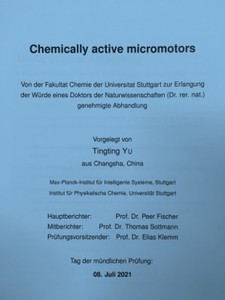Chemically active micromotors
2021
Ph.D. Thesis
pf
Motion is a mark of living systems. It is realised by energy conversion to perform vital tasks and is thus of great importance for all living systems. One approach to achieve motion is by including active motion of micro/nano objects. Unlike in the fluid at the macro scale, active swimming cannot be achieved by reciprocal movements at the micro scale. Breaking symmetry at the micro scale thus becomes a critical issue. The challenge is that this often requires outside intervention to build systems that already show symmetry breaking. And another challenge is that there are few examples where active microscale motion can cause a macroscopic effect, or facilitate a useful application. In the first part of the thesis, the first challenge is addressed and a new route of spontaneous symmetry breaking is developed. Microscale motion in artificial chemical systems has thus far been realised in chemical motion. These are microparticles that are fabricated to possess two different halves, known as Janus particles. One half is catalytically active and drives the self-phoretics. The Janus micromotors are generally fabricated using fabrication techniques such as PVD, CVD. These techniques require deposition onto a surface, which limit the number of structures that can be fabricated. In this work, we show that two species of isotropic (symmetric) micro particles, one is a photocatalytically active particle TiO2, the other is a passive SiO2 particle can spontaneously form a dimer structure. Under UV illumination, a chemical gradient is generated around the photo active particles. The passive particle is attracted toward the highest chemical concentration of the reaction product towards the active particle. A dimer forms that starts to self-propel. The speed of the dimer can be controlled by adjusting the UV intensity. The mechanism of the dimer formation is examined and shown to be due to a diffusiophoretic interaction between the active and the passive particle. The interaction force and the propulsion of the dimer swimmers are examined. The role of salts, particle size and concentration are studied. An additional repulsion interaction is observed between two active particles. An optimal volumetric particle density of ≤ 2% is identified for dimer formation and the dimers remain active for > 20s. This thesis thereby demonstrates a self-assembly route where the chemical activity causes dimer formation and thus spontaneous symmetry breaking which does not require any physical fabrication steps. Most work thus far has studied the behaviour of individual chemical micromotors (Janus particles) at the micro scale. To induce a macroscopic effect and facilitate an application using individual micro/nano active particles requires cooperative effects of many "micromotors". Therefore, we developed a novel fabrication method which allows a large number of Janus structures to be assembled in an ordered manner. We fabricated an array of photoactive Janus micro structures on a surface by glancing angle deposition (GLAD) onto a photolithography patterned substrate. Illuminating the surface of Janus array structures with UV light initiates the water splitting reaction, which produces an osmotic flow around the micro structures. The osmotic flow at each structure is coupled with the flows generated by the neighbouring particles. The microscopic osmotic flow thereby results in a macroscopic fluid flow. By adjusting the spacing between single micro structures, an optimised pumping velocity is achieved with a micro pillar diameter of 2 μm and a spacing of ∼ 2 μm. We compared the pumping performance of the micro pillar array with other topological chemical structures, such as micro Janus bar arrays and 2D micro Janus disk arrays, and find that the 3D structure is essential to generate a chemical gradient on the surface. We believe that this is the first chemical micropump formed by chemically active Janus structures. The active pumping surface can provide a flow speed of up to 4 μm/s. This active surface consisting of micropillar arrays can be easily integrated in most microchannels and serve as an on-board micropump. A theoretical model and numerical simulations are presented to describe the microchannel pumping. The theory reproduces the experimentally measured flow profiles very well. We have thus established a new type of chemical pump, which can wirelessly pump fluid in a microchannel, and the pumping volume rate and flow profile can be modified simply by changing the nature and orientation of the self-pumping walls.
| Author(s): | Yu, Tingting |
| Year: | 2021 |
| Month: | July |
| Day: | 8 |
| Department(s): | Micro, Nano, and Molecular Systems |
| Bibtex Type: | Ph.D. Thesis (phdthesis) |
| Address: | Stuttgart |
| School: | University of Stuttgart |
| Degree Type: | PhD |
| DOI: | 10.18419/opus-11606 |
|
BibTex @phdthesis{2021TY,
title = {Chemically active micromotors},
author = {Yu, Tingting},
school = {University of Stuttgart},
address = {Stuttgart},
month = jul,
year = {2021},
doi = {10.18419/opus-11606},
month_numeric = {7}
}
|
|


